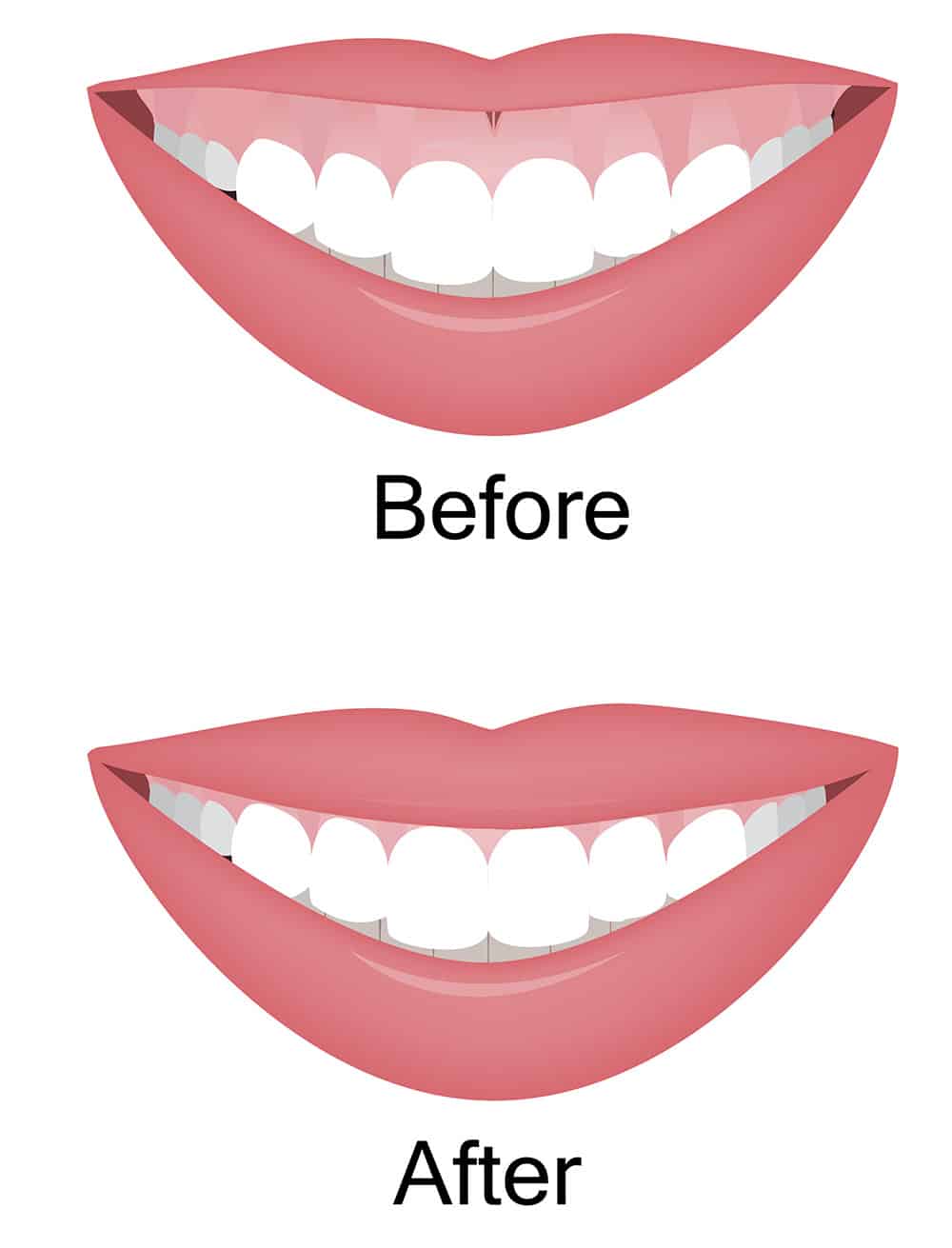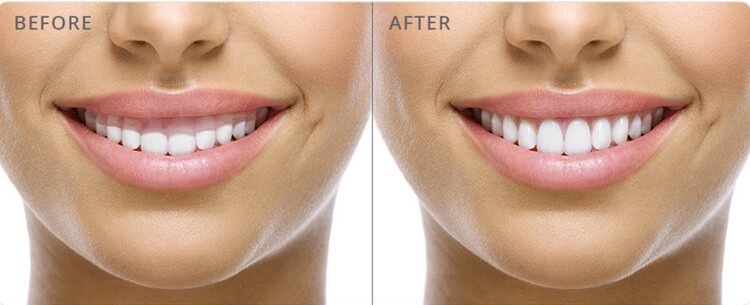Perfecting Your Smile: Say Goodbye to Gummy Smiles!
Gummy bears are cute but not gummy smiles!
Are you conscious of smiling in public due to your gummy smile?
Is your confidence taking the hit due to your smile?
We have a perfect solution for you! We will be able to address your problem by performing a treatment called esthetic crown lengthening.
In crown lengthening, Dr. Adatrow adjusts the gum and bone level to reveal more of the tooth so that it can be treated or restored. During the dental crown lengthening process, excess gum and bone tissue are reshaped to disclose more natural teeth. Crown lengthening can be either esthetic or functional crown lengthening based on the reason for doing crown lengthening. For correcting gummy smile, esthetic crown lengthening is performed. Crown lengthening might be done on a single tooth or multiple teeth based on the requirements.

Benefits of Esthetic Crown Lengthening
Before/After Gum Contouring Treatment

Ready to get started?
Reach us now to schedule your consultation
Frequently Asked Questions on Esthetic Crown Lengthening
What is a gummy smile?
A gummy smile, or "excessive gingival show," is a smile in which the gums appear prominently, making the teeth look smaller than usual. This may be because the gums, teeth, or jaws are out of proportion to the other parts, or because the upper lip is hypermobile. Gummy smiles are generally caused by biology, but they can also be the product of some drugs.
What are the causes of the gummy smile?
- Genetics
- Physiology
- Medications
- Poor oral hygiene
- Orthodontic braces
- Upper lip muscle hyperactivity
- An irregular eruption of your permanent teeth
- Upper jawbone growth
How can my gummy smile be corrected?
A gummy smile can be transformed into a beautiful smile by any of the following procedures:
- Gingivectomy
- Crown lengthening
- Orthognathic surgery
- Lip repositioning
- Botox
What is gingival (gum) contouring?
Gum contouring or gum reshaping is a cosmetic procedure that may alter the shape of your gums. A dentist may use this procedure to remove excess gum tissue that gives you a "gummy" smile or restore receded gum tissue, exposing your teeth. This is a form of gingivectomy.
What is a gingivectomy?
Gingivectomy or gingivoplasty requires removing excess gum tissue to remove periodontal pockets or have better visibility of teeth. Excess gum tissue can occur as a side effect of some drugs like anticonvulsants, antihypertensives, and others. Thick tissue will function as a spring, making it more challenging to move your teeth with braces. So, orthodontists utilize this technique to move teeth to desirable positions. This technique is also called esthetic crown lengthening.
What is gum?
Gum, also known as gingiva, is a pink-colored soft tissue surrounding your teeth. It helps in holding your teeth in place.
How are genetics related to gummy smiles?
Genetics has a crucial role in the causation of the gummy smile. It can range from a combination of large jaws to small teeth. Rarely, gummy smiles can be caused by a disorder known as hereditary gingival fibromatosis (HGF), gradual but progressive enlargement of the gingiva that is often extreme enough to cause speech problems.
Why was I recommended gum contouring?
Suppose you have an excessive show of gums while smiling. In that case, Dr. Adatrow might recommend you a gummy smile treatment called gum contouring. In clinical terms, this excessive exposure of gums is called prolonged gingival exposure.
Can I undergo sedation for crown lengthening treatment?
Yes, if you are anxious about dental treatments, undergoing sedation might be a good option. You can openly talk about your fears and concerns regarding your dental treatments with Dr. Adatrow during your first dental visit. Dr. Adatrow will take the utmost care of you and address all your problems.
What is the difference between gum contouring and esthetic crown lengthening?
There is no difference between the two. They are the same.
What is a crown lengthening?
Crown lengthening adjusts the gum and bone level to reveal more of the tooth to be treated or restored. During the dental crown lengthening process, excess gum and bone tissue are reshaped to disclose more natural teeth.
What are the types of dental crown lengthening?
The type of crown lengthening would depend on the reason for doing the crown lengthening. The two types of crown lengthening are functional and esthetic crown lengthening.
- Esthetic crown lengthening is completed to help correct the gummy smile of the patient. Mostly, it happens when the gums cover too much of the crown, making the tooth look smaller or shorter than it should be.
- Functional crown lengthening is a surgical procedure that might be necessary if you break a tooth below the gum line or if reconstruction allows a larger number of tooth structures to be exposed for proper support. This procedure aims to change the gum level and provide sufficient room for Dr. Adatrow to restore the area properly.
What measures will be taken before the gum reshaping procedure?
Our dental team will record your medical history and X-rays (radiographs) to understand teeth and bone condition before undergoing the crown lengthening procedure. You should also provide information about the medication you are taking. This will enable us to recommend if you have to stop any medicines before the procedure. If required, Dr. Adatrow will also record an impression for your temporary crown.
How is gum contouring performed?
During the crown lengthening procedure, Dr. Adatrow removes the gums to separate them from the teeth and reveals the roots and bones to adjust the bone level. However, in some situations, only the gum tissue is removed. The doctor will wash the surgical area with saltwater and then suture the gums back together, often holding a bandage over the region for extra protection. The procedure is done under local anesthesia.
Do medicines cause gummy smiles?
Certain prescription medicines have side-effects like gingival enlargements (gingival hypertrophy), leading to a gummy smile. Some of these medications are heart disease drugs (Nifedipine, Verapamil, and Diltiazem), anti-epilepsy medicines (Phenytoin), and immunosuppressants (Cyclosporine A).
How does Botox treat gummy smiles?
Botox is the least intrusive and shortest-term way to cope with a gummy smile. Botox operates by momentarily paralyzing the elevator muscles so that the upper lip does not rise dramatically. Although this is cheaper and easier than surgery, the effects generally last only around three to four months. Botox needs to be repeated regularly for any long-term results. However, suppose you're considering repositioning your lips for a gummy smile. In that case, Botox may be a perfect way to assess what you're going to look like when you're having surgery.
Can gum reshaping be performed with a laser?
Yes, dental crown lengthening can be performed with a laser. Instead of using a scalpel, Dr. Adatrow uses a laser to remove the gum tissue. Crown laser lengthening offers gentle, minimally invasive treatment solutions that are reliable and predictable. It results in less irritation, swelling, and bleeding.
Is gum contouring long-lasting?
Yes, since Dr. Adatrow recontours the bone just below the gums, the gums will remain in the treated position.



